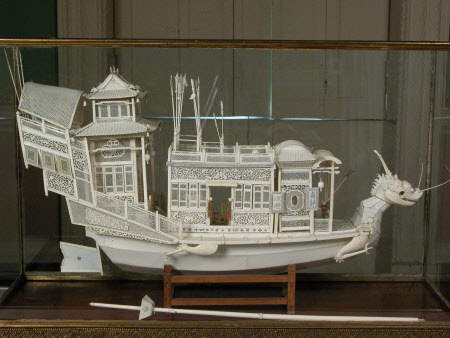Model junk
Category
Ivory and bone
Date
1750 - 1775
Materials
Ivory, painted; glass and brass
Measurements
540 x 840 x 330 mm
Place of origin
Guangzhou
Order this imageCollection
Osterley Park and House, London
NT 771742.1
Caption
A Chinese Junk is a type of ship, still in use today. This model ‘Royal Junk’ was for the Emperor and has a dragon head on its prow.
Summary
Model of a Chinese sampan, one of a pair, painted ivory on wooden bases with glass cover. On the sampan there is a 'house' with a portico in the middle, a second 'house' with a second level at the end, with a dragon head at the front. Spheres and lamps on the roof of the houses in the middle. The vessels were known as 'Royal Junks', the dragon prow was for the Emperor and the phoenix for the Empress. The base is rectangular veneered with walnut, inlaid with stringing lines in a light wood round the edge. There is a brass strip with a guilloche motif along each side and a tapered brass foot at each corner.
Full description
Model of a Sampan with a dragon prow, made in Guangzhou (Canton), circa 1750-75. Canton artisans were skilled in carving ivory imported from South and South-East Asia. Sampan or pleasure boats were a familiar sight to visitors to Canton and these models were made as novel souvenirs for Western visitors. A similar model in the VIctoria and Albert Museum was acquired in Canton by Richard Hall (1764-1834), the 'supercargo' or senior officer in charge of the East India Company's operations in China between 1785 and 1802.It was propelled by a clockwork motor.
Provenance
Child Family Heirlooms. The 1782 inventory records in the [Long] Gallery 'Two India Sandpans[Sampans] of Ivory with Plate Glass Cases in brass frames on two and gold Japanned Tables'.
Marks and inscriptions
LHS when dragon head facing viewer: 萬国衣冠拜冕楼 萬 – ten thousand 国 – country 衣 – clothes 冠 – crown 衣冠 – the gentry or educated elite 拜 – to worship, to bow 冕 – imperial crown 楼 – tower, building The tower where the gentry or educated elite from all countries bow before the imperial crown. RHS when dragon head facing viewer: 九天閶闔開宮殿 九 – nine 天 – heaven, sky 九天 – refers to the nine layers of heaven, often seen as the supreme celestial domain, where divine beings and heavenly rulers reside 閶闔– grand gate of the imperial palace (often refers to the entrance of heaven or the palace of celestial beings) 開 – open, unfold 宮殿 – palace The heavenly gates open to reveal the imperial palace. Above dragon's head when facing viewer - underneath central roof.: 錦波 錦 – brocade, rich or beautiful fabric 波 – wave, ripple brocade waves or elegant ripples. Both sides of Junk (LHS sign): 迴避 迴 – to turn, to return 避 – to avoid, to evade to evade, to step aside, to avoid confrontation (This sign generally indicates that unauthorized individuals should avoid getting near the area, particularly during important judicial or governmental proceedings.) In ancient China, these two signs were commonly placed in front of government buildings, courts, and offices of high-ranking officials. Both sides of Junk (RHS sign): 肅靜 肅 – solemn, respectful, serious 靜 – quiet, still, calm absolute silence, solemn quiet (This sign generally instructs people not to engage in discussions or make noise near the building.) In ancient China, these two signs were commonly placed in front of government buildings, courts, and offices of high-ranking officials. Back of 'building' in middle: 月门 月 – moon, month 门 – door, gate, entrance Moon gate. Back of Junk: 順風相送 順2 – smooth, favourable (' ‘頁' engraved upside down on junk - previous repairs?) 風 – wind 相 – mutual, each other 送 – too send, to escort 順風 – favourable wind, smooth sailing, or going with the wind 相送 – to bid farewell, to send someone off to wish someone a smooth and easy journey, much like a farewell blessing.
